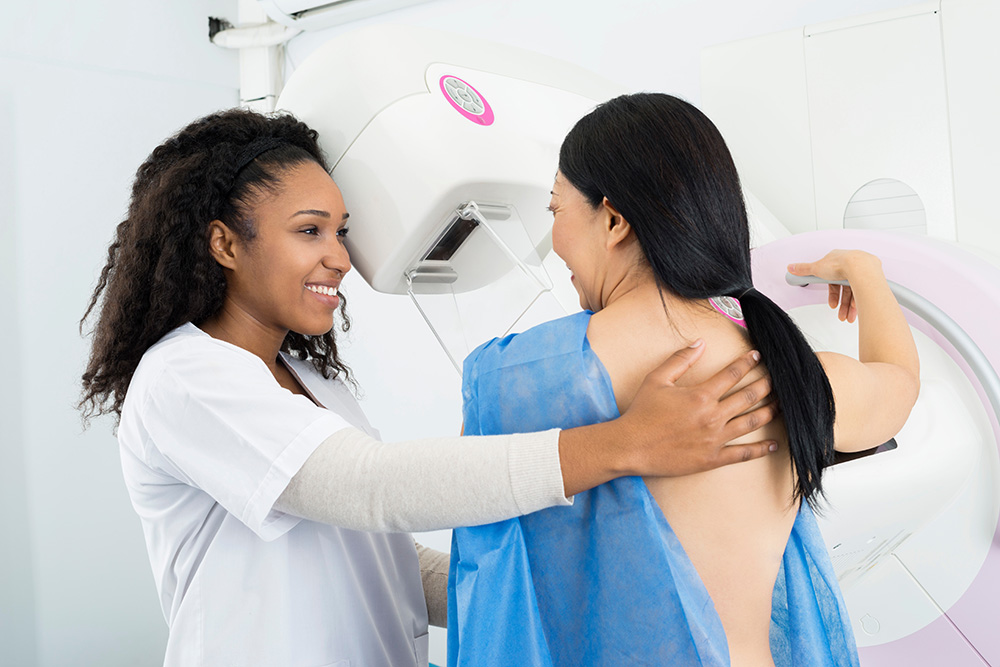
Updated breast cancer screening guidelines in 2024 lowered the recommended mammogram screening age.
According to updated guidelines from the U.S. Preventive Services Task Force (USPSTF), all women regardless of personal or family medical history should see their doctor for a mammogram screening beginning at age 40. This is different from the previous USPSTF recommendation to start getting mammograms sometime between the ages of 40 and 50.
The Task Force – an independent panel whose recommendations have significant influence over health care standards – explained that its decision in 2024 to lower the mammogram screening age guideline was based on rising rates of breast cancer among women in their 40s in recent years.
Maria Nelson, MD, chief of breast, endocrine and soft tissue surgery at the USC Breast Center, part of Keck Medicine of USC, says “mammogram is the gold standard” for detecting breast cancer. She says she has long encouraged her “average risk” patients (i.e., those without family history or genetic risk) to start screening at age 40.
“Groups like the American College of Radiology and the American Society of Breast Surgeons were already adhering to those recommendations,” she explains. “I’m glad the Task Force has finally aligned on that.”
Mary Yamashita, MD, chief of breast imaging in the department of radiology at Keck Medicine of USC, as well as Dr. Nelson both caution that the updated guidelines do not go far enough.
“Women at high risk of genetic mutation may need to start screening mammography at age 30 or sooner with breast MRI,” says Dr. Yamashita. According to the American College of Radiology guidelines, all women, particularly Black and Ashkenazi Jewish women, should have a breast cancer risk assessment by age 25 to decide if screening mammography should begin earlier than age 40.
Mammogram frequency by age
How often should women get mammograms? The Task Force advises getting a screening every other year. However, experts at Keck Medicine of USC urge patients to get a mammogram annually.
“The best way to detect the earliest, most favorable kind of cancer, which is stage zero, is through mammography,” stresses Dr. Nelson, who is also a clinical associate professor of surgery at the Keck School of Medicine of USC as well as an associate member of the USC Norris Comprehensive Cancer Center.
“You don’t want a tumor percolating and growing into something bigger. Two years of growth could be the difference between a lumpectomy versus a mastectomy, or needing chemotherapy,” Dr. Nelson says. “I would rather a patient detect something early when we have more choices and could avoid more aggressive treatment.”
Dr. Yamashita, a clinical professor of radiology at the Keck School, noted a higher incidence of advanced cancers in women due to many missing their yearly mammograms during the height of the COVID-19 pandemic.
“Reflecting on this, if they had continued with their annual mammograms, perhaps we would have detected those cancers at earlier stages,” says Dr. Yamashita. “I firmly believe that all women at average risk should begin receiving screening mammograms at age 40, and then every year rather than every other year.”
What age can women stop getting mammograms?
The Task Force says women should continue with biyearly mammograms through age 74. However, Dr. Yamashita says the decision to stop should depend entirely on the health of the individual patient.
“We frequently see women in their 80s who are thriving. Detecting cancer early in these patients allows for less aggressive treatment compared to those who do not undergo regular screenings,” she explains.
“It doesn’t make sense to impose an age restriction on mammograms. As long as the life expectancy is more than 10 years, you should continue to have annual mammograms.”
Why should younger women get mammograms?
While the risk of developing breast cancer increases with advanced age, research published in JAMA Network Open shows that younger women tend to face more powerful forms of the disease.
“Women in their 30s and 40s are more likely to develop faster-growing breast cancers,” says Dr. Yamashita. “For instance, triple-negative breast cancer is the most aggressive type, and it’s more commonly diagnosed in younger women than in women in their 60s or 70s.”
She continues, “This is one of the reasons why younger women need to be screened annually so that if they do develop breast cancer, we can treat it before it grows or spreads.”
Dr. Yamashita further clarifies that the stage of breast cancer, including whether the cancer has spread at the time of diagnosis, significantly affects the outcome and survival. “The goal is to detect breast cancer at its earliest stage in younger women, who are more likely to have aggressive cancers. That’s why it’s important to start getting mammograms at age 40 and have them every year.”
Dr. Nelson further cautions that “the majority of people diagnosed with breast cancer don’t have any family history or high-risk features. For women, there is a one-in-eight chance you’ll get breast cancer sometime in your life.”
She adds, “Mammograms save lives. Get your screening every year, and encourage every woman in your life to do the same.”
Topics
